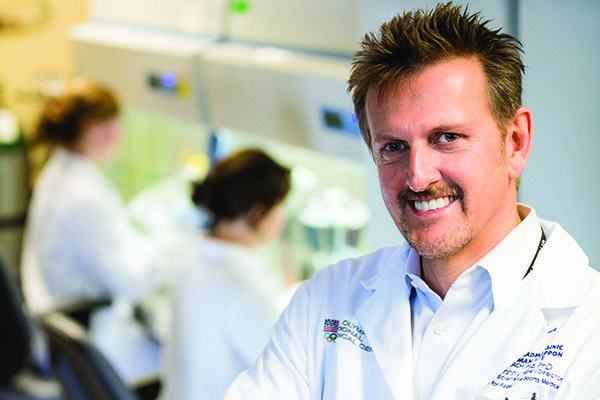News
Fountain Of Youth

This article was first printed in the 2019 Vail Health Magazine.
The number of people age 90 or older will quadruple between 2010 and 2050. But what’s the point of living longer if you’re burdened with disease and degeneration?
Not much, which is why Johnny Huard, PhD and other scientists have been studying healthy aging for 25 years. Dr. Huard is the chief scientific officer and director of the Center of Regenerative Sports Medicine at Steadman Philippon Research Institute, and he and other researchers may have found the key to slowing the effects of aging and helping people recover from injuries, illnesses and degeneration. After decades of clinical trials, scientists finally understand why people age at a cellular level: essentially, our stem cells become dysfunctional, less active or “tired,” as Dr. Huard explains it.
DIET AND EXERCISE
Dr. Huard asserts that healthy aging relies on five pillars: healthy diet, lifestyle, personalized medicine, regenerative medicine and prescription medications. Each of these five fundamentals contributes to supporting healthy stem cells. These interventions won’t transform a 50-year-old into a 25-year-old, but they can assist that older person in aging much better from age 50 on.
A healthy lifestyle — including a ketogenic diet (low carb, high healthy fat intake), exercise and stress reduction — already goes a long way in preventing excess stem cell decay.
“Nutrition is vital. Eat less and live longer,” Dr. Huard says, adding that studies have shown the combination of a ketogenic diet, moderate calorie restriction and 14-hour fasts between dinner and breakfast increase health span in humans and lower risks for diabetes, cancer and aging in general.
Stem cells originate in blood vessel walls, so exercise is important because it increases vascularity, which results in more stem cells and, ultimately, faster healing and slower aging. He recommends a moderately to intensely active lifestyle.
But obviously, diet and exercise alone don’t prevent stem cells from eventually dying off. As it turns out, other cells in the body, called senescent cells, drive inflammation and literally turn healthy cells into dysfunctional ones by producing molecules that disturb the function of neighboring cells. So, the question becomes: Can we stop these nasty senescent cells?
SUPPLEMENTS
Studies show we can, and that’s where personalized medicine, regenerative medicine and medication come into play.
Dr. Huard begins with personalized medicine: He tests blood for a host of markers most doctors don’t routinely look for, including vitamin E, hormone, mineral levels, heavy metals, etc. Once people bring their blood markers to baseline readings, he recommends the next two steps: regenerative medicine and medication.
Supplements and prescription drugs are the most straightforward, though Dr. Huard cautions people to work with their doctors, as some medications and supplements are contraindicated in certain situations. Several prescription drugs look promising in their ability to kill senescent cells.
STEM CELLS
Regenerative medicine, the fifth pillar of anti-aging, includes stem cell banking. At birth, all of our cells are “good,” accommodating 100% rejuvenation potential. By age 50, only 50% of our cells are “good,” and at around 75, only 25% have regenerative potential, due to the destructive force of senescent cells.
In a study of mice with progeria (accelerated aging and its related, debilitating symptoms), mice injected with 500,000 young stem cells lived three times longer with significantly better health than noninjected mice. Another study showed that young mice receiving blood from old mice aged prematurely, and old mice receiving blood from young mice slowed down their aging process; these old mice also suddenly possessed rejuvenating factors, including the ability to fight Alzheimer’s disease. And, the results seem to transfer to humans, too. Dr. Huard asserts that, on average, women (and female animals) live longer than males because more women than not become pregnant and benefit from the young stem cells of their fetuses, women who become pregnant between age 40 and 50 age slower and achieve extreme longevity, he says.
“Your stem cells may prove someday to be a lifesaver,” Dr. Huard says, adding that the best gift parents can give their baby involves “banking” the stem cells in the umbilical cord. “Stem cell banking is the best investment you can make in your life.”
The process of banking usually involves extracting 10 cc of fat and freezing the stem cells. Dr. Huard began banking his a year ago.
However, a few major sticking points still exist. First of all, there are companies who take people’s money and don’t follow the proper banking procedures, Dr. Huard says. The cost to bank stem cells is approximately $6,000 to $7,000, but that amount only covers the actual banking process; getting stem cells re-injected into the body costs much more. And, the main problem in this nation is that the FDA has approved the removal and freezing of stem cells, but it hasn’t approved injecting them back into the body.
The FDA wants to ensure scientists growing stem cells have mastered the technique because “a lot of things can go wrong,” Dr. Huard says. Still, other countries such as Germany and Mexico regularly grow and re-inject banked stem cells into people. Dr. Huard and others are committed to educating the FDA about how they have discovered safe ways to grow the necessary amount of stem cells. Perhaps in the future, we will not need to grow all stem cells if we know in advance the cells that are the best for healthy aging.
Ultimately, Dr. Huard sees a day where stem cells are banked at birth, or at least banked prior to soldiers being deployed, astronauts launching into space and diseases progressing. Banked, younger stem cells can help those astronauts counteract high radiation exposure, help the wounded warriors heal and save older people from age-related degeneration. Though stem cell research suggests profound breakthroughs, it’s important to remember that it’s not the only intervention necessary for healthy-aging effects; diet, exercise and personalized and regenerative medicine all play a role.
“It’s not going to be one thing. It’s going to be multiple things, and it’s not going to be tomorrow; it’s going to take time,” Dr. Huard says. “The goal is not to make you look younger. It is to make you age better.”
Learn More:
Steadman Philippon Research Institute (SPRI) is recognized worldwide for its orthopaedic research into the causes, prevention and treatment of orthopaedic disorders. Committed to solving the orthopaedic problems that limit an individual's ability to maintain an active lifestyle, SPRI's primary areas of research and education include basic scientific studies, clinical research, biomedical engineering, imaging research and education and fellowship. The SPRI team collects data and publishes clinical research results on knees, hips, shoulders and spine as well as imaging studies, making the Institute one of the most published organizations in sports medicine research and education.
More News
-
New!
More

Screening Secrets: What Every Man Should Know About Prostate Cancer Screening
Prostate cancer is the most common type of non-skin related cancer in men, and it is the second leading cause of cancer-related deaths in men within the United States, behind lung cancer. Fortunately, if caught early, prostate cancer remains highly treatable and curable with minimally invasive procedures.
-
New!
More

Unplug to Recharge: Why a Digital Detox Is the Real Power Move for 2026
Our phones promise connection, convenience and control, yet most of us feel more scattered, stressed and sleepless than ever. The constant pings, scrolls and notifications have rewired our brains for distraction. The fix? Not abandoning technology altogether, but reclaiming balance.
-
New!
More

Beyond the Scale: Why Nutrition and Exercise Work Better Together
For decades, weight loss advice has been distilled into a simple equation: calories in, calories out. Eat less, maybe combine that with exercise, and the pounds will fall away. But according to experts at Vail Health, that equation overlooks a much bigger picture.





